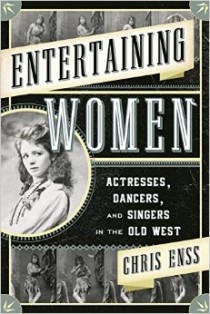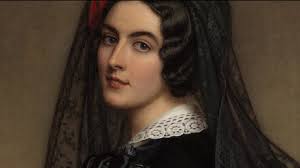1898 – A posse led by Valentine Hoy cornered escaped convicts Harry Tracy, Dave Lant, and Swede Johnson in Browns Park, Colorado. As he approached them Hoy was shot through the heart by Tracy.
Cherokee Lawman
Enter now to win a copy of
Sam Sixkiller: Cherokee Frontier Lawman
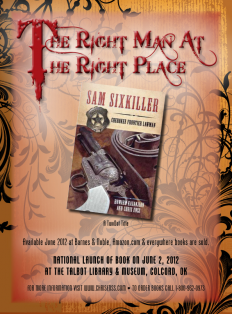
Sam Sixkiller was one of the most accomplished lawmen in 1880s Oklahoma Territory. And in many ways, he was a typical law enforcement official, minding the peace and gun slinging in the still-wild West. What set Sam Sixkiller apart was his Cherokee heritage. Sixkiller’s sworn duty was to uphold the law, but he also took it upon himself to protect the traditional way of life of the Cherokee. Sixkiller’s temper, actions, and convictions earned him more than a few enemies, and in 1886 he was assassinated in an ambush.
This biography takes a sweeping, cinematic look at the short, tragic life of Sam Sixkiller and his days policing the streets of the Wild West. Sam Sixkiller: Cherokee Frontier Lawman was honored by the Oklahoma Historical Society as the Most Outstanding Book on Oklahoma History in 2012.
To learn more about
Sam Sixkiller and his career as a fearless peace officer read
Sam Sixkiller: Cherokee Frontier Lawman
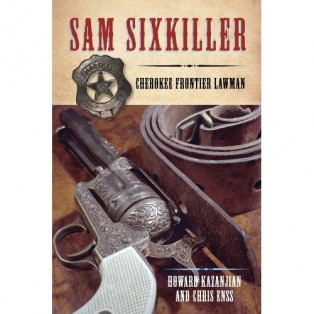
This Day…
Dear Mr. Gable
Last chance to enter to win a copy of
Entertaining Women:
Actresses, Dancers, and Singers in the Old West
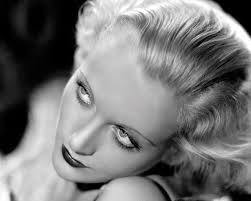
When movie star Carole Lombard died suddenly at the age of 33, some said it was the end of an era-not just of her hilarious brand of screwball comedies like My Man Godfrey and Twentieth Century but off-screen , too, where her raucous and profane wit made her one of the most fun people in Hollywood. She was the type of star little girls dreamed of becoming: not only was she beautiful and glamorous, she was also married to Clark Gable, creating one of the most sensational love matches in Hollywood’s golden days.
The pair were so well liked that it made perfect sense for them to be asked to headline the first war-bond drive after Pearl Harbor. The campaign would peak in Indianapolis, in Lombard’s home state, so she decided to go anyway after Gable declined and took along her mother instead. On one night, January 15, 1942, Lombard helped raised more than $2 million, four times what organizers hoped for. Afterward, Lombard was eager to get back to California, so she instructed her agent to book them on an airplane flight instead of the train. Lombard’s mother was most reluctant. She had never flown before and her numerologist had told her that January 16 was an unlucky day for flying.
Lombard flipped a coin, an after the star called tails and won, the two women and the press agent took off at 4 a.m., Friday, January 16, on a flight that included several stops and was to take seventeen hours. One stop Friday afternoon was in Albuquerque, New Mexico, where several military officers wanted to board and displace civilian passengers. Four passengers got off the plane, but Lombard, pointing out that she had just raised $2 million for the war effort, convinced the pilot to add three seats and let her and her companions continue the flight.
The plane made one last stop, in Las Vegas, to refuel, then took off at 7:07 p.m. headed for Los Angeles. About a half hour later workers at the Blue Diamond Mine south of Las Vegas reported seeing a bright flash atop a distant mountain and then heard an explosion. It seems the pilot, who had been reprimanded several times before for disobeying flight regulations, was flying off course over the mountains to try and make up for lost time from all the previous stops. The plane grazed a rocky projection than slammed into a wall of Table Rock Mountain near its peak at 8,000 feet.
It took rescue workers, led by a local 70-year-old Indian, almost a day to climb the steep cliffs and read the crash site, surrounded by snow several feet deep. There was no snow near the destroyed plan. Many of the nineteen passengers and three crew members, including Lombard, were so badly burned, they couldn’t be identified. It was several days before all the bodies could be removed from the mountains.
Gable, who had flown to the area and paced nervously until it was clear there were no survivors, soon afterward enlisted in the Army Air Force as a 41-year-old private.
To learn more about Carole Lombard’s and about the other talented performers of the Old West read
Entertaining Women: Actresses, Dancers, and Singers in the Old West.
This Day…
The Emotional Actress
Enter now to win a copy of
Entertaining Women: Actresses, Dancers, and Singers in the Old West
Winners will be announced on February 28, 2016
Long before actors were vying for an Oscar nomination and world wide fame thespians were trying to carve out a modest living entertaining prospectors and settlers of the Old West. Today the curtain goes up on a woman entertainer who captured the hearts of the western pioneers.
Ladies and gentlemen, Charlotte Thompson,
The Emotional Actress
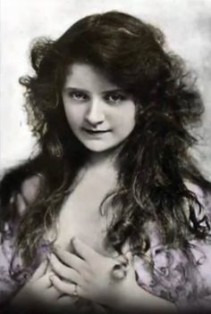
Among the many talented, intrepid actresses who performed in the Old West were London born Charlotte Thompson. She came to the United States with her father in 1850s. Jane Eyre was one of her major roles. She played the part in 1874, 1883-85 and toured several eastern U.S. as Jan Eyre from 1875, 1877, 1885, 1887.
Miss Charlotte Thompson. It is a pleasure to announce the coming to San Antonio next week of this charming lady. Miss Thompson is one of the best emotional actresses of the American stage, especially in the noble passion which make womanhood admirable. None can see Miss Thompson, in her impersonations, without loving and respecting woman more and more, and on the account, we consider her a great actress, and one certainly whom everyone should come out to patronize. These are our thoughts of her most recent work.
“A large audience was amply rewarded last evening for its attendance at the opera house, in the play Drifting Clouds as produced by the well known emotional actress, Charlotte Thompson, and her excellent company. The character of Phyllis Denoir, impersonated by Miss Thompson, was one of the most exacting nature, but the role suffered nothing at her hands. It was a very strong piece of emotional acting carried out with strict propriety and without any of the very ragged bits of passion so often seen in like situations. The drama itself is a powerful one, and without the few humorous moments with which it is so pleasantly interspersed, would, with Miss Thompson’s acting, be almost too tragically intense to afford pleasure. While the art of the author carries on the plot throughout with interest the happy denouncement leaves nothing to be desired at its termination.”
San Antonio Times March 19, 1890
To learn more about
Charlotte Thompson’s illustrious career and her performances across the Old West read
Entertaining Women: Actresses, Dancers, and Singers in the
Old West.
This Day…
Pink Tights and Cracked-Voice
Take a chance. Enter to win a copy of
Entertaining Women: Actresses, Dancers, and Singers in the Old West
Winners will be announced on February 28, 2016
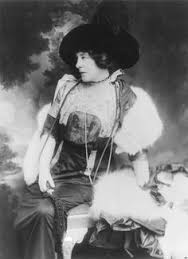
Long before actors were vying for an Oscar nomination and world wide fame thespians were trying to carve out a modest living entertaining prospectors and settlers of the Old West. Today the curtain goes up on a woman entertainer who captured the hearts of the western pioneers.
Ladies and gentlemen, Songstress Antoinette Adams
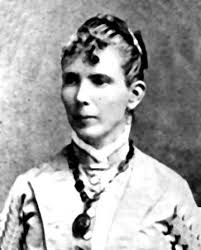
The first actress to appear in Virginia City was Antoinette Adams, variously described as six feet tall, long-necked, Roman-nosed, cracked-voiced, and a faded blonde. Although her audience of miners were cruelly disappointed in what they saw and heard, they listened patiently through her first rendition. At the first pause in her performance, a burly miner stood up and ordered the audience to give three cheers for “Aunty.”
The cheers resounded, and Antoinette sang again. Once more the miners applauded her, then one man rose to suggest they give her enough money to retire from her profession. A shower of silver cascaded upon the stage, the audience rowdily saluting her retirement. After that, every time Antoinette opened her mouth to sing, the miners cheered her so lustily she could not be heard; they also hurled more silver at her feet. At last the actress surrendered, ordered the curtains pulled. When she gathered the silver up, it filled two money sacks. But Antoinette could take a hint; she left town the next day.
To learn more about
Antoinette Adam’s not so illustrious career
and her performances across the Old West read
Entertaining Women: Actresses, Dancers, and Singers in the
Old West.
This Day…
The President’s Opera Star
Enter to win a copy of
Entertaining Women: Actresses, Dancers, and Singers in the Old West
Winners will be announced on February 28, 2016
Long before actors were vying for an Oscar nomination and world wide fame thespians were trying to carve out a modest living entertaining prospectors and settlers of the Old West. Today the curtain goes up on a woman entertainer who captured the hearts of the western pioneers.
Ladies and gentlemen, Madame Adelina Patti,
The President’s Opera Star
Among the many stars that performed at Piper’s Opera House in Virginia City, Nevada in the late 1870s was a beautiful soprano by the name of Adelina Patti. Adelina was a highly acclaimed 19th-century opera singer, earning huge fees at the height of her career in the music capitals of Europe and America. She first sang in public as a child in 1851, and gave her last performance before an audience in 1914. Along with her near contemporaries Jenny Lind and Theresa Tietjens, Patti remains one of the most famous sopranos in history, owing to the purity and beauty of her lyrical voice and the unmatched quality of her bel canto technique. Bel canto is a lyrical style of operatic singing using a full rich broad tone and smooth phrasing.
During an American tour in 1862, she sang John Howard Payne’s Home Sweet Home at the White House for the President of the United States, Abraham Lincoln, and his wife Mary. The Lincolns were mourning their son Willie, who had died of typhoid. Moved to tears, the Lincolns requested and encore of the song. Henceforth, it would become associated with Adelina Patti, and she performed it many times as a bonus item at the end of recitals and concerts.
Patti’s career was one of success after success. She sang not only in England and the United States, but also as far afield in mainland Europe as Russia, and in South America as well, inspiring audience frenzy and critical superlatives wherever she went. Her girlish good looks gave her an appealing stage presence, which added to her celebrity status.
To learn more about
Adelina Patti’s career and her performances in America read
Entertaining Women: Actresses, Dancers, and Singers in the
Old West.
